Wire Electrochemical Machining with Pulsating Radial Electrolyte Supply and Preparation of Its Tube Electrode with Micro-Holes
Abstract
:Featured Application
Abstract
1. Introduction
2. Methods
2.1. Principle of WECM with Pulsating Radial Electrolyte Supply
2.2. Drilling Varying Micro-Holes with ECMD on a Tube Electrode
2.3. Experimental Procedures
3. Results and Discussion
3.1. Influence of Pulse Duty Cycle
3.2. Influence of Pulse Frequency
3.3. Influence of Feed Rate and Applied Voltage
3.4. Drilling Varying Holes with Different Applied Voltages at a Same Feed Rate
4. WECM with Pulsating Radial Electrolyte Supply
4.1. Preparation of Tube Electrodes
4.2. Cutting Kerfs on a 30 mm-Thick Block
5. Conclusions
- (1)
- To obtain higher machining accuracy and better processing quality, a duty cycle of 20% and a pulse frequency of 100 kHz were used.
- (2)
- Using multivariate regression analysis, the quantitative relationship among the applied voltage, the electrode feed rate, and the diameter of the side holes was determined. The feasibility of fabricating tube electrodes with varying-diameter holes in the side by regulating the applied voltage on-line was shown.
- (3)
- Using the varying-diameter tube electrode, three kerfs with a length of 10 mm and an averaged width of 0.903 mm can be machined at a feed rate of 6 μm/s in 30-mm-thick block, and there are no short circuits during processing.
- (4)
- Experiments shown that using a tube electrode with micro-holes of variable diameter provides better processing capacity for the method of pulsating radial electrolyte supply in WECM.
Author Contributions
Funding
Conflicts of Interest
References
- Klocke, F.; Bergs, T.; Doebbeler, B.; Binder, M.; Seimann, M. Multi-criteria assessment of machining processes for turbine disc slotting. J. Manuf. Mater. Process. 2018, 2, 32. [Google Scholar] [CrossRef] [Green Version]
- Zeng, Y.B.; Yu, Q.; Wang, S.H.; Zhu, D. Enhancement of mass transport in micro wire electrochemical machining. CIRP Ann. Manuf. Technol. 2012, 61, 195–198. [Google Scholar] [CrossRef]
- Kim, B.H.; Na, C.W.; Lee, Y.S.; Choi, D.K.; Chu, C.N. Micro electrochemical machining of 3D micro structure using dilute sulfuric acid. CIRP Ann. Manuf. Technol. 2005, 54, 191–194. [Google Scholar] [CrossRef]
- Zhu, D.; Wang, K.; Qu, N.S. Micro wire electrochemical cutting by using in situ fabricated wire electrode. CIRP Ann. Manuf. Technol. 2007, 56, 241–244. [Google Scholar] [CrossRef]
- Shin, H.S.; Kim, B.H.; Chu, C.N. Analysis of the side gap resulting from micro electrochemical machining with a tungsten wire and ultrashort voltage pulses. J. Micromech. Microeng. 2008, 18, 1–6. [Google Scholar] [CrossRef]
- Kalaimathi, M.; Venkatachalam, G.; Sivakumar, M.; Ayyappan, S. Experimental investigation on the suitability of ozonated electrolyte in travelling-wire electrochemical machining. J. Braz. Soc. Mech. Sci. 2017, 39, 4589–4599. [Google Scholar] [CrossRef]
- Fang, X.L.; Zou, X.H.; Chen, M.; Zhu, D. Study on wire electrochemical machining assisted with large-amplitude vibrations of ribbed wire electrodes. CIRP Ann. Manuf. Technol. 2017, 66, 205–208. [Google Scholar] [CrossRef]
- Zou, X.H.; Fang, X.L.; Zeng, Y.B.; Zhu, D. A high efficiency approach for wire electrochemical micromachining using cutting edge tools. Int. J. Adv. Manuf. Technol. 2017, 91, 3943–3952. [Google Scholar]
- Fang, X.L.; Zhang, P.F.; Zeng, Y.B.; Qu, N.S.; Zhu, D. Enhancement of performance of wire electrochemical micromachining using a rotary helical electrode. J. Mater. Process. Technol. 2016, 227, 129–137. [Google Scholar]
- Volgin, V.M.; Lyubimov, V.V.; Kukhar, V.D.; Davydov, A.D. Modeling of wire electrochemical micromachining. Proc. CIRP 2015, 37, 176–181. [Google Scholar] [CrossRef] [Green Version]
- Maeda, R.; Chikamori, K.; Yamamoto, H. Feed rate of wire electrochemical machining using pulsed current. Precis. Eng. 1984, 6, 193–199. [Google Scholar] [CrossRef]
- Qu, N.S.; Fang, X.L.; Li, W.; Zeng, Y.B.; Zhu, D. Wire electrochemical machining with axial electrolyte flushing for titanium alloy. Chin. J. Aeronaut. 2013, 26, 224–229. [Google Scholar] [CrossRef] [Green Version]
- He, H.D.; Qu, N.S.; Zeng, Y.B.; Fang, X.L.; Yao, Y.Y. Machining accuracy in pulsed wire electrochemical machining of γ-TiAl alloy. Int. J. Adv. Manuf. Technol. 2016, 86, 2353–2359. [Google Scholar] [CrossRef]
- Béjar, M.A.; Eterovich, F. Wire-electrochemical cutting with a NaNO3 electrolyte. J. Mater. Process. Technol. 1995, 55, 417–420. [Google Scholar] [CrossRef]
- Klocke, F.; Herrig, T.; Klink, A. Evaluation of wire electrochemical machining with rotating electrode for the manufacture of fir tree slots. Proc. ASME Turbo Expo 2018, 6, 1–6. [Google Scholar]
- Zhang, H.; Xu, J.; Wang, J. Investigation of a novel hybrid process of laser drilling assisted with jet electrochemical machining. Opt. Lasers Eng. 2009, 47, 1242. [Google Scholar] [CrossRef]
- Bleys, P.; Kruth, J.P.; Lauwers, B.; Schacht, B.; Balasubramanian, V.; Froyen, L.; Humbeeck, J.V. Surface and sub-surface quality of steel after EDM. Adv. Eng. Mater. 2006, 8, 15–25. [Google Scholar] [CrossRef]
- Tsui, H.P.; Hung, J.C.; You, J.C.; Yan, B.H. Improvement of electrochemical micro drilling accuracy using helical tool. Mater. Manuf. Process. 2008, 23, 499–505. [Google Scholar] [CrossRef]
- Liu, Y.; Li, M.H.; Niu, J.R.; Lu, S.Z.; Jiang, Y. Fabrication of taper free micro-holes utilizing a combined rotating Helical electrode and short voltage pulse by ECM. Micromachines 2019, 10, 28. [Google Scholar] [CrossRef] [Green Version]
- Zou, X.H.; Fang, X.L.; Zeng, Y.B.; Zhang, P.F.; Zhu, D. In situ fabrication of ribbed wire electrodes for wire wlectrochemical micromachining. Int. J. Electrochem. Sci. 2016, 11, 2335–2344. [Google Scholar]
- Koyano, T.; Kunieda, M. Ultra-short pulse ECM using electrostatic induction feeding method. Procedia Cirp 2013, 6, 390–394. [Google Scholar] [CrossRef] [Green Version]
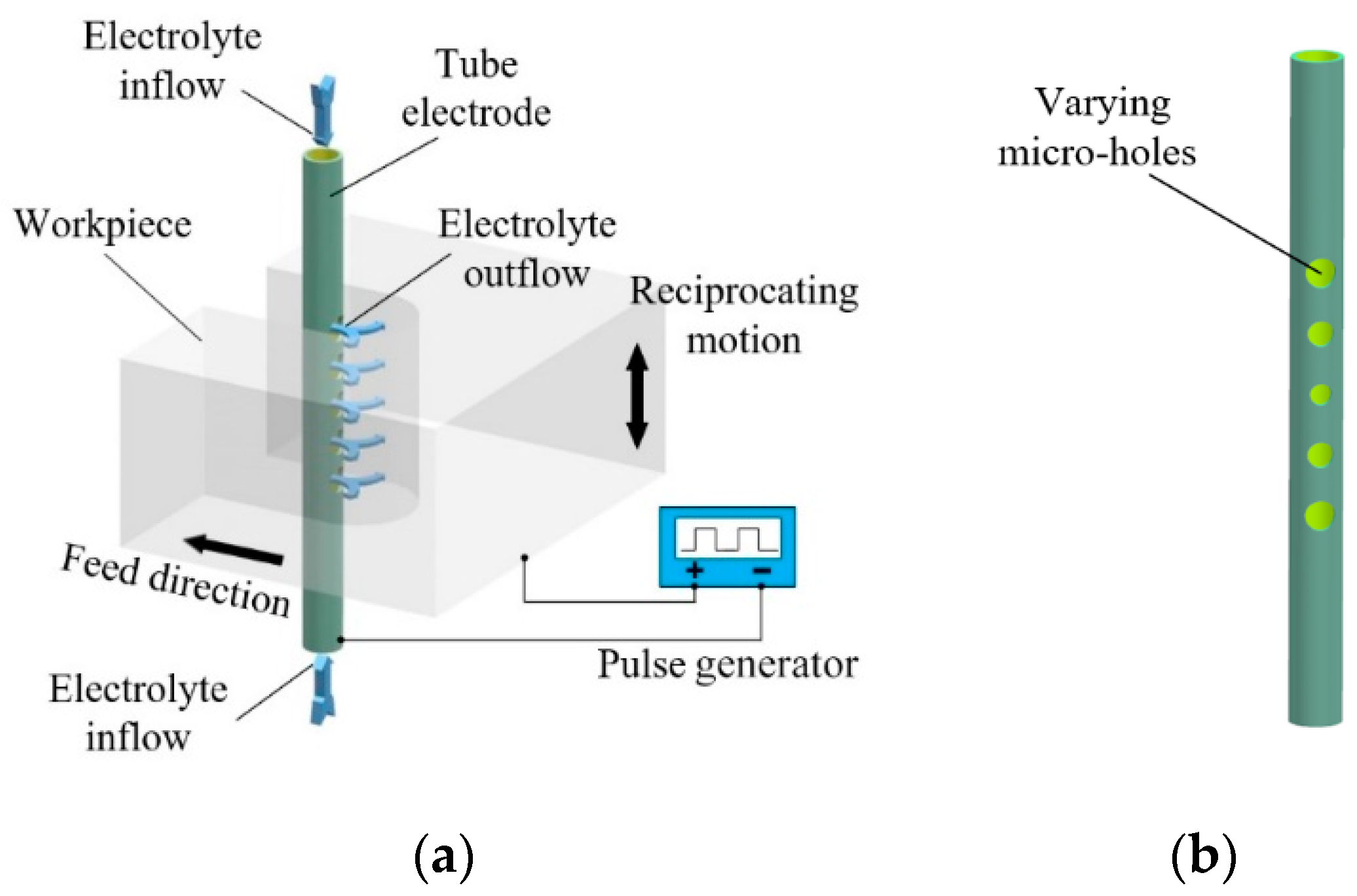

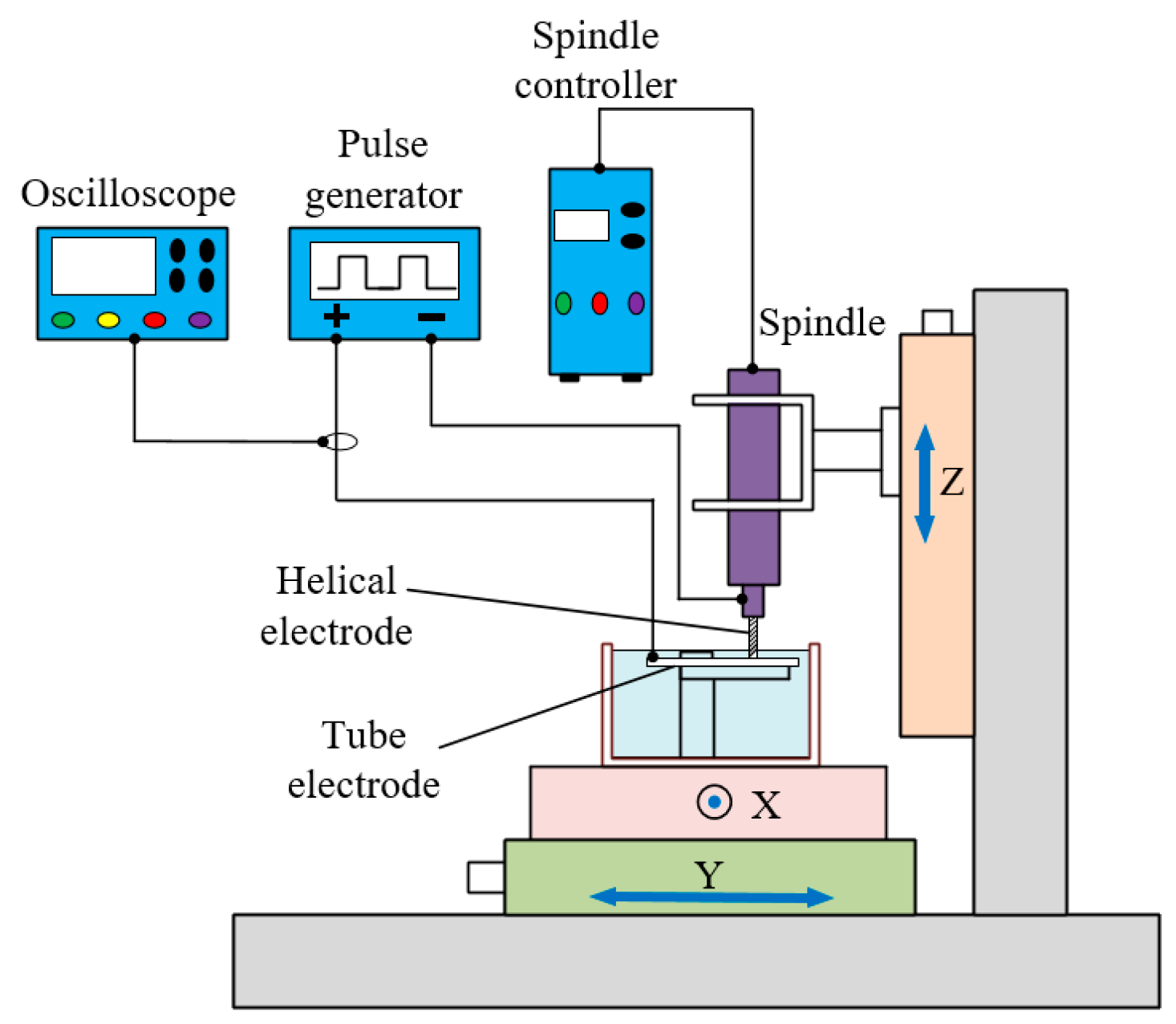
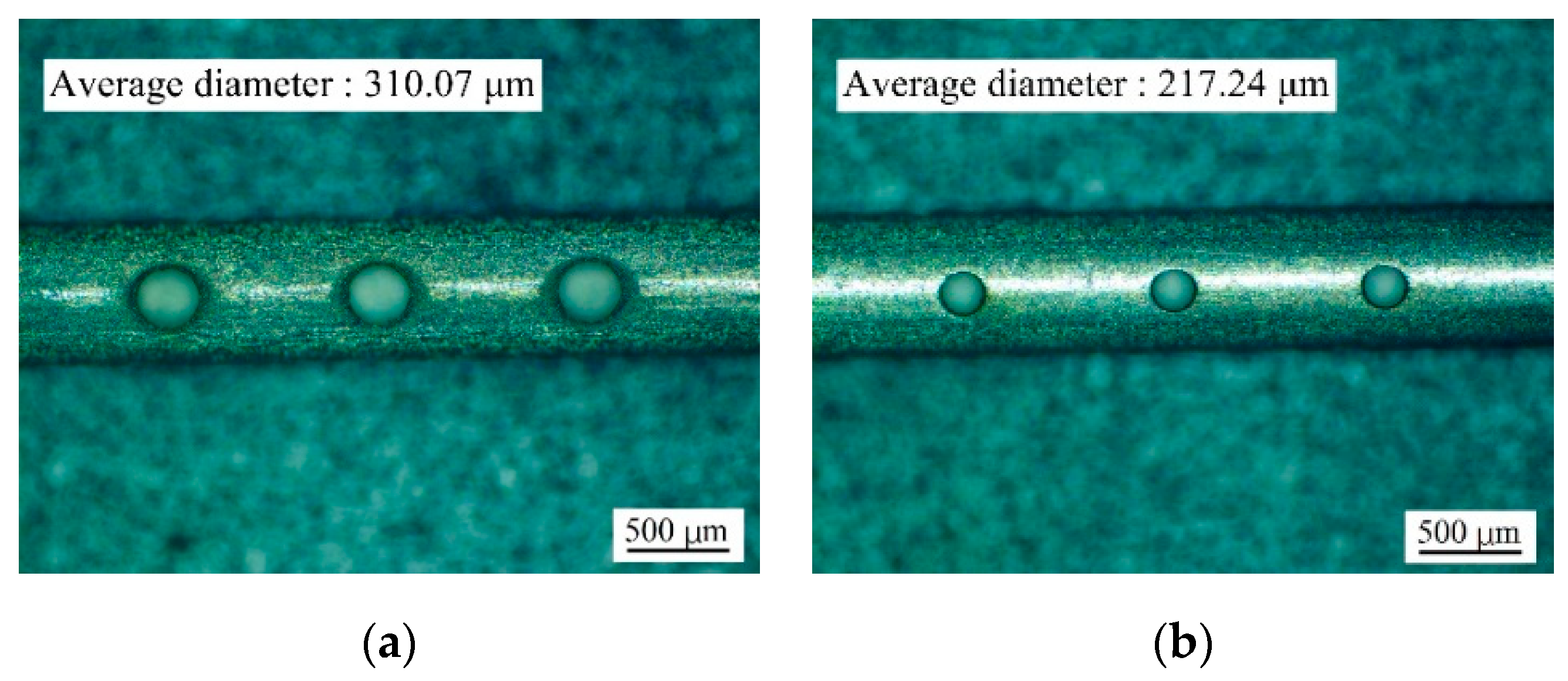
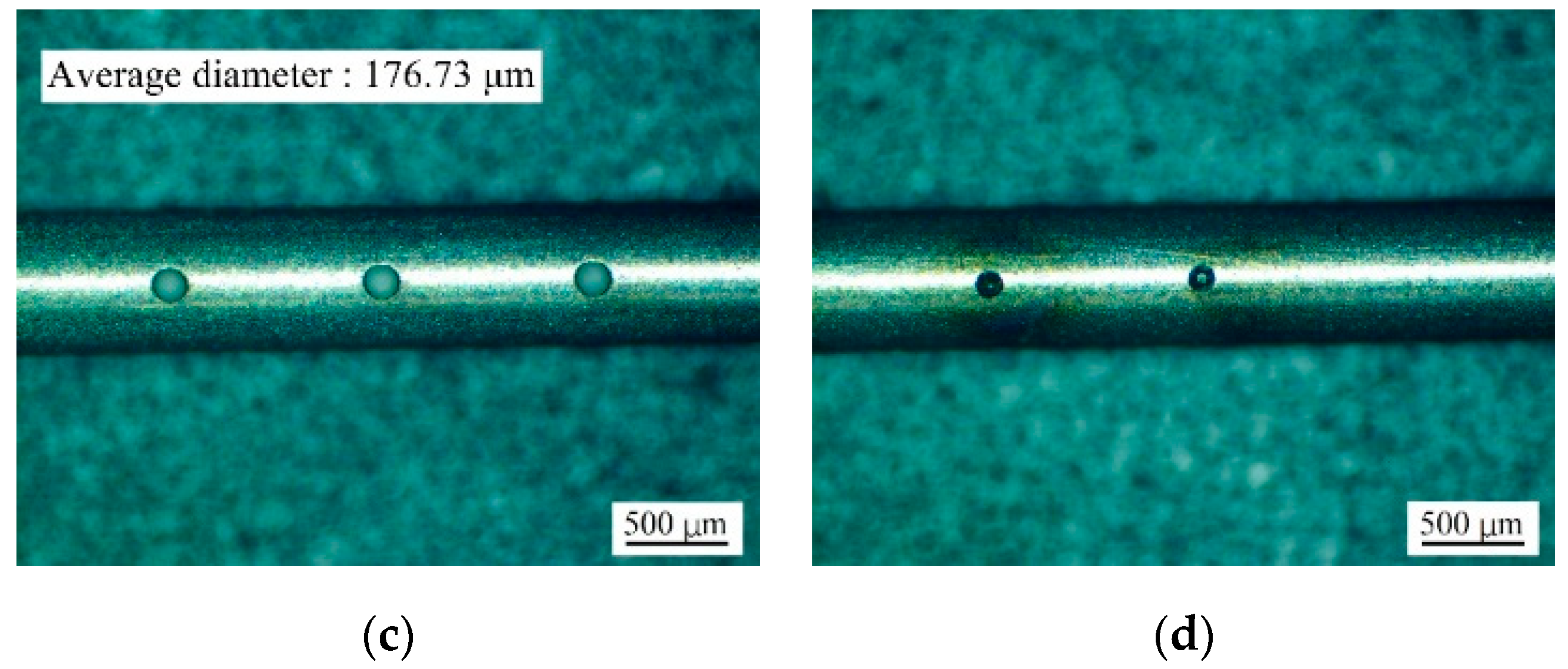
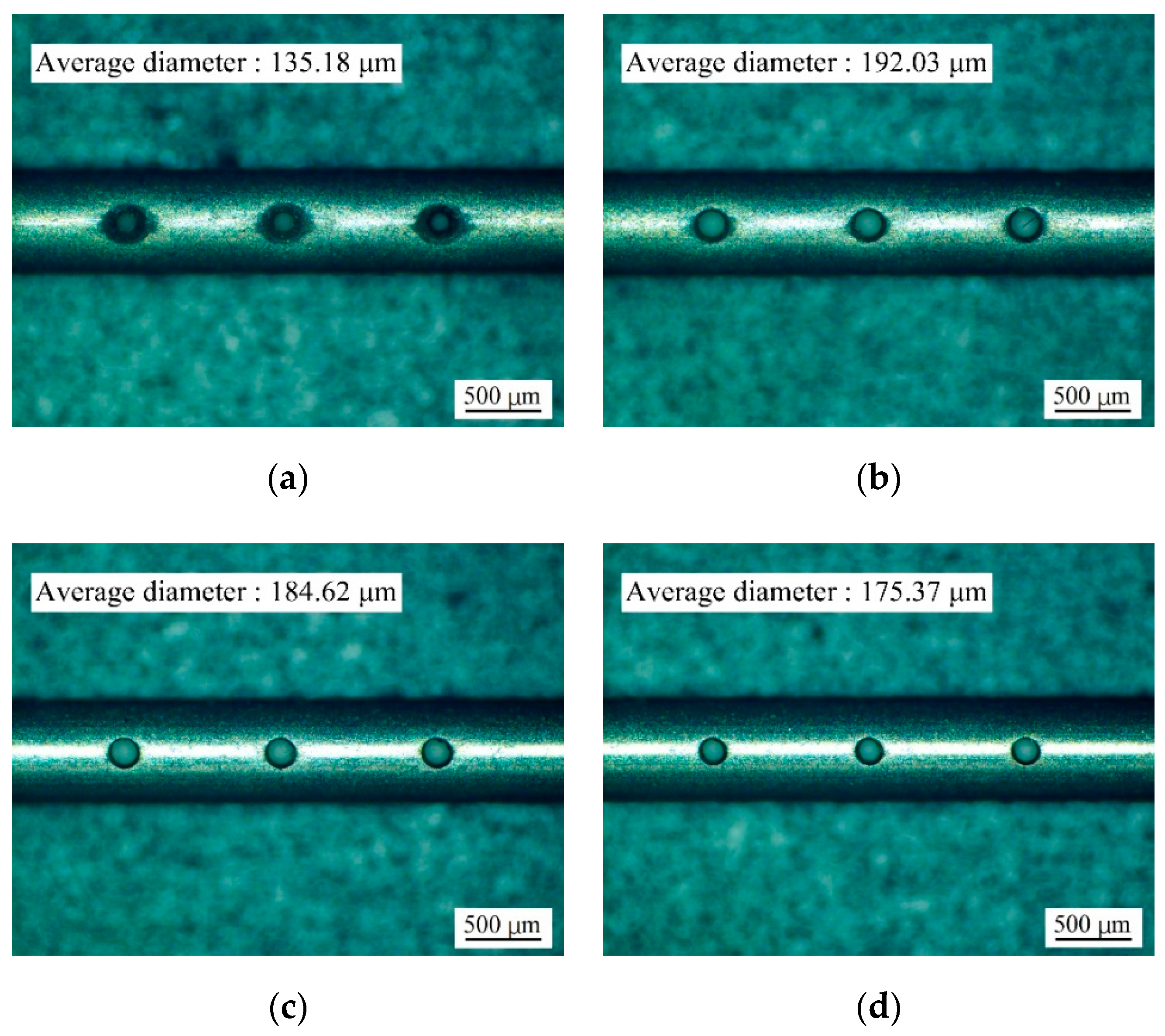
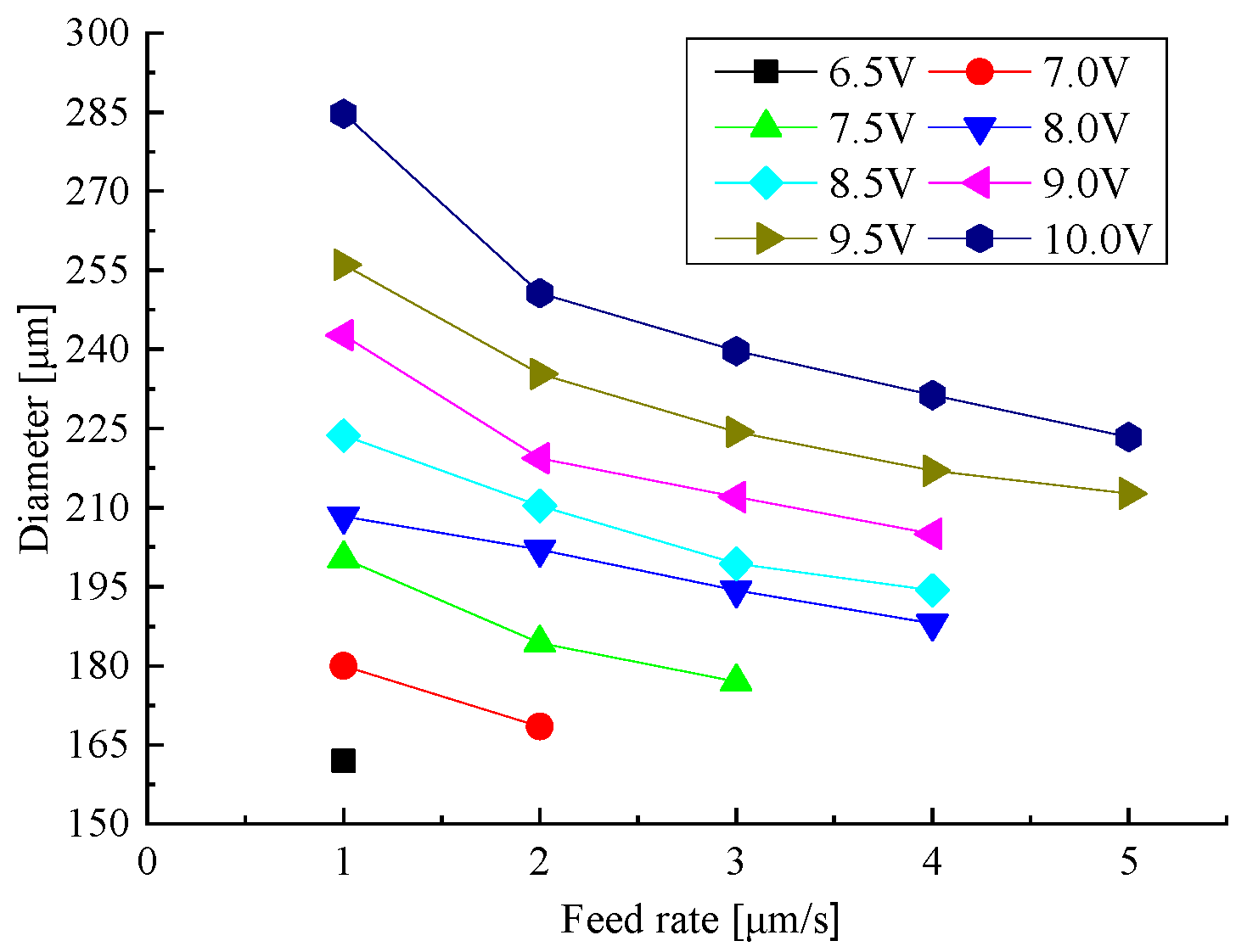

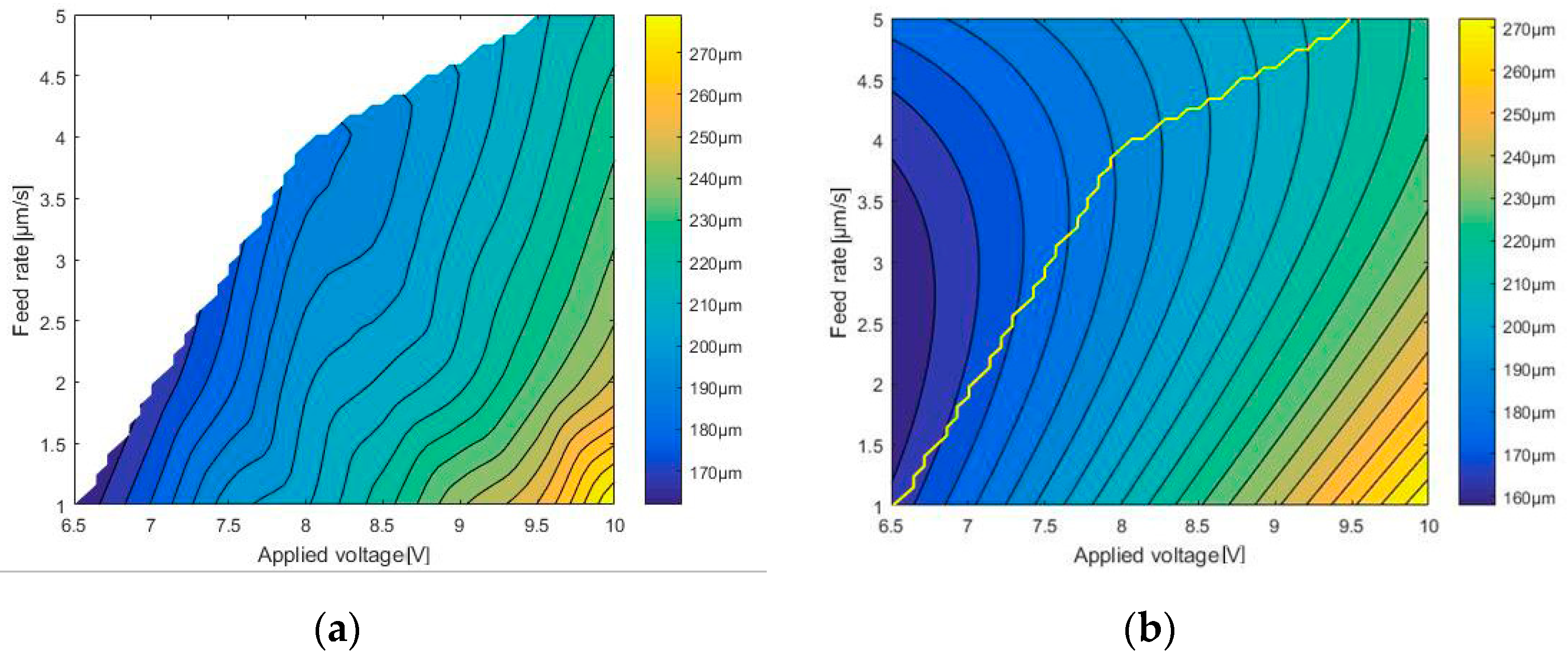
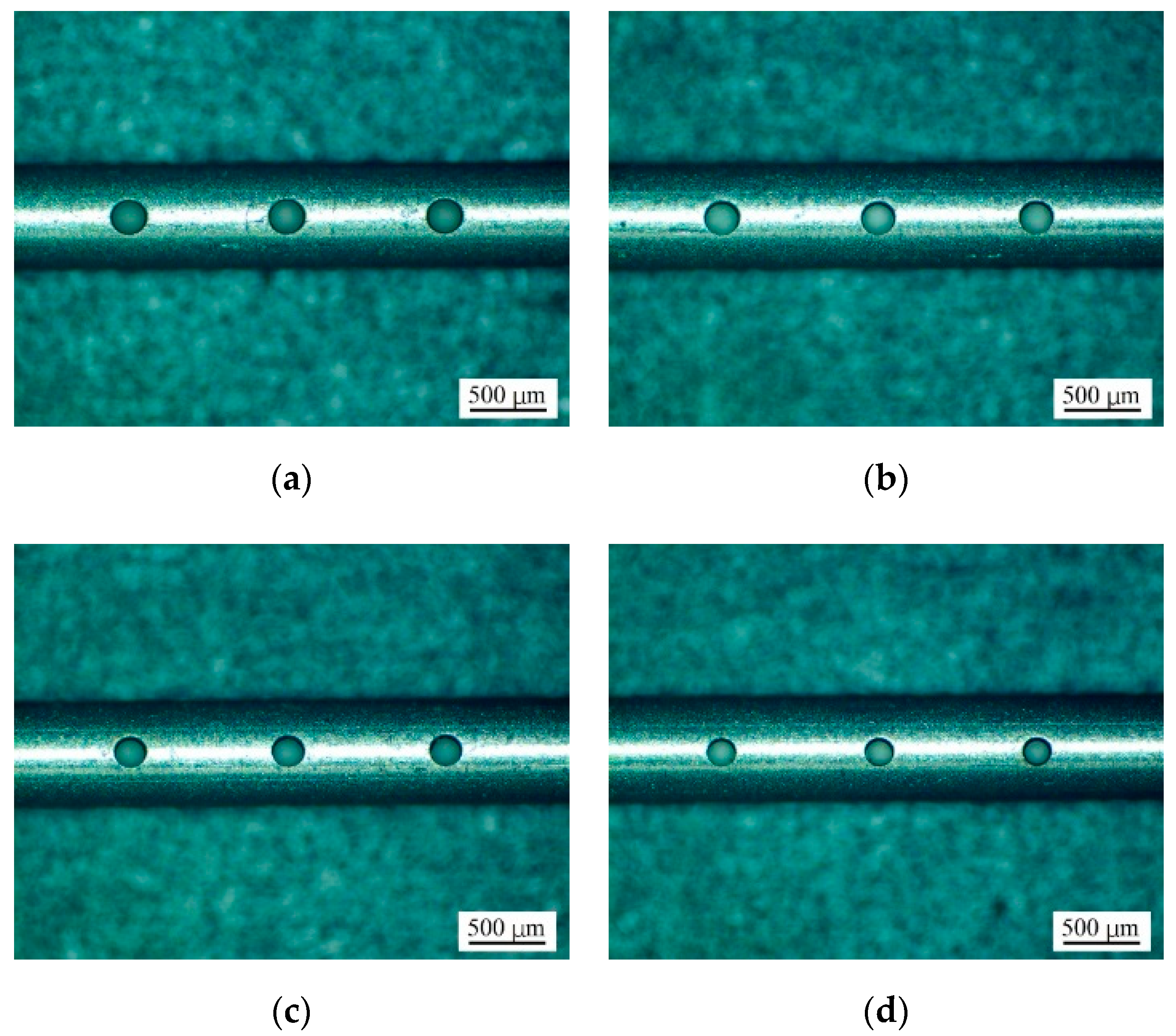

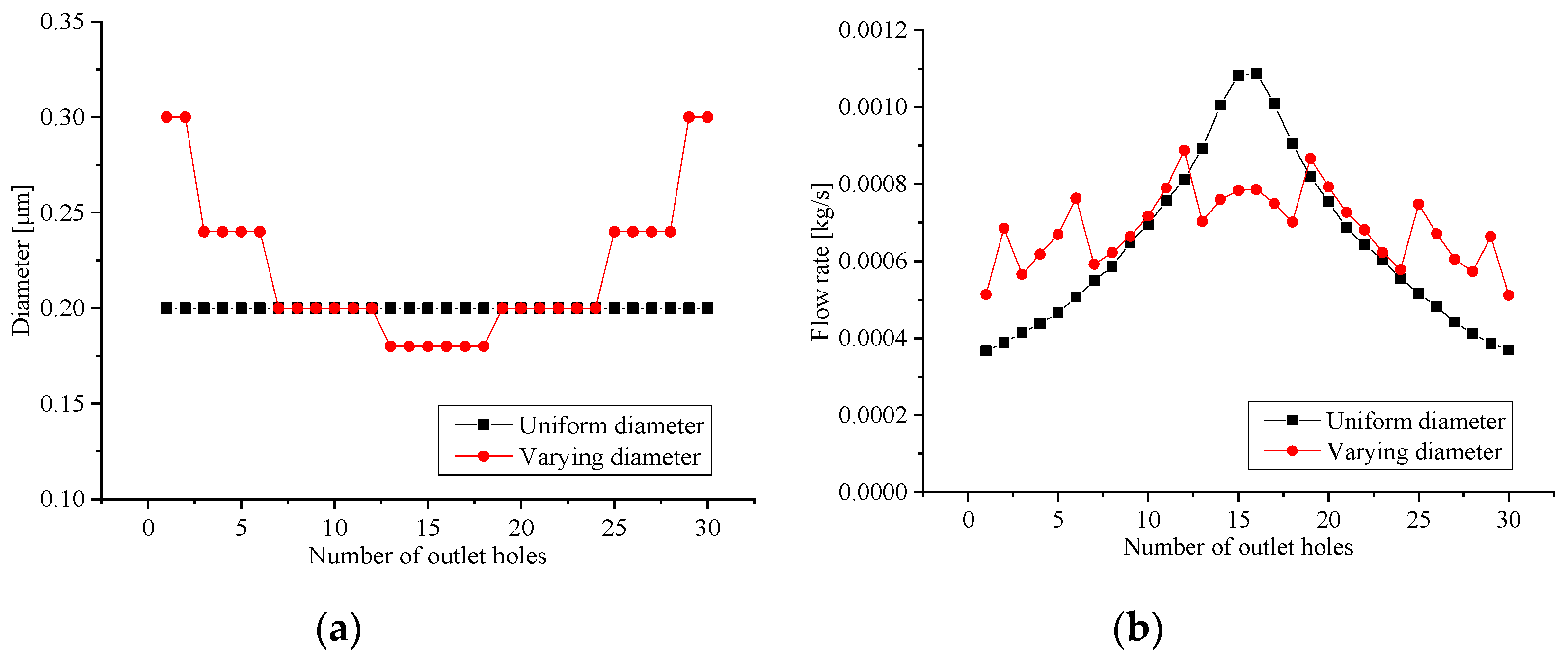
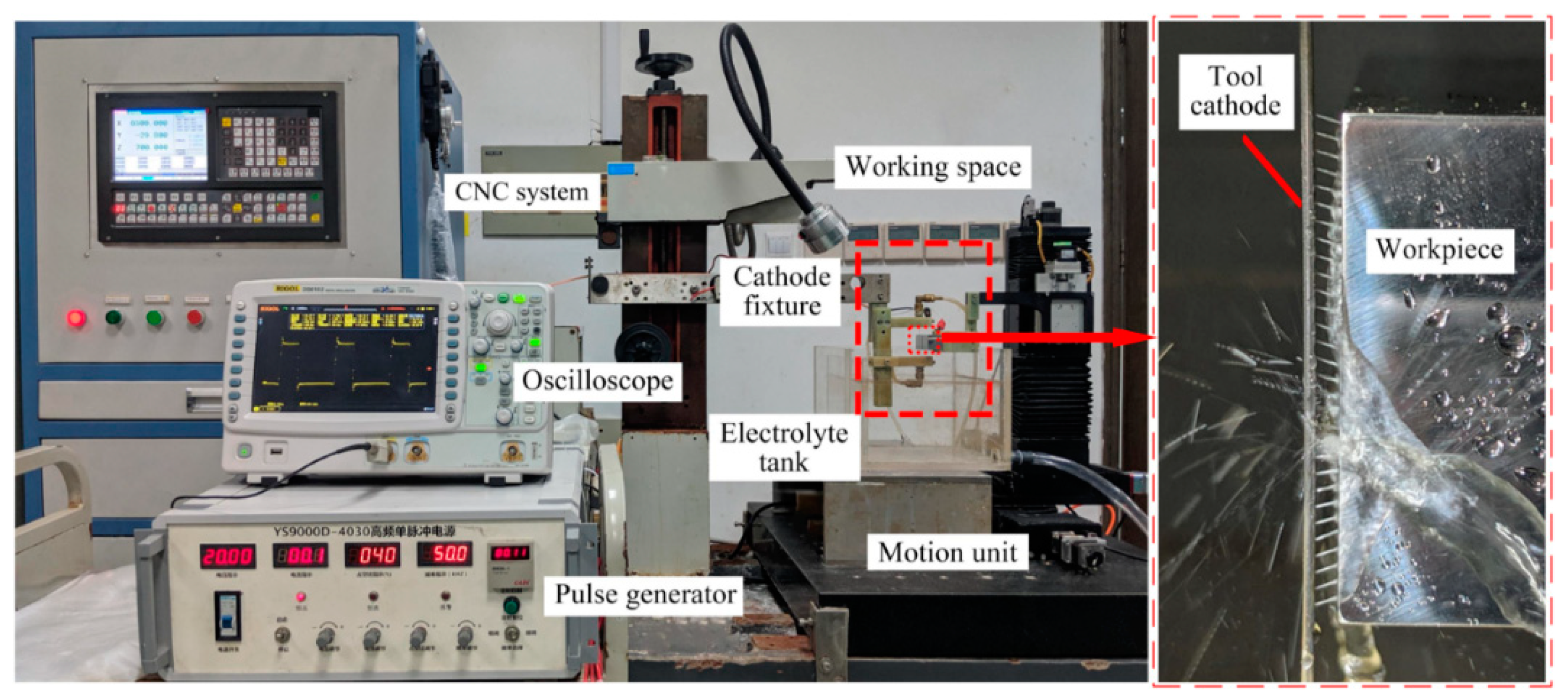
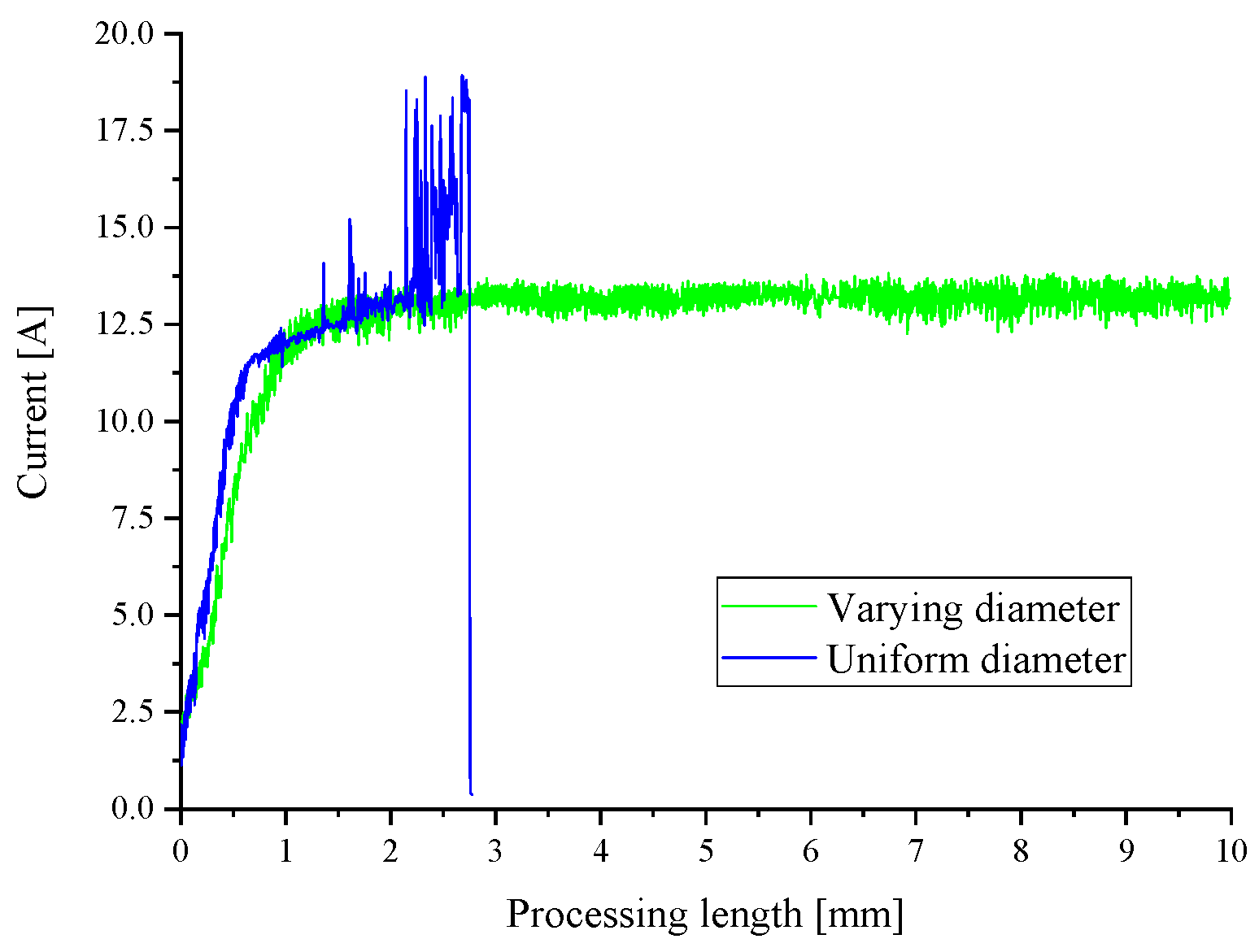


| Parameter | Value |
|---|---|
| Applied voltage (V) | 7.5 |
| Frequency (kHz) | 100 |
| Pulse duty cycle | 50%, 30%, 20%, 10% |
| Feed rate (μm/s) | 1.5 |
| Parameter | Value |
|---|---|
| Applied voltage (V) | 7.5 |
| Frequency (kHz) | 10, 20, 50, 100 |
| Pulse duty cycle | 20% |
| Feed rate (μm/s) | 1.5 |
| Parameter | Value |
|---|---|
| Applied voltage (V) | 6.5, 7.0, 7.5, 8.0, 8.5, 9.0, 9.5, 10.0 |
| Feed rate (μm/s) | 1, 2, 3, 4, 5 |
| Desired Diameter (μm) | Applied Voltage (V) | Average Diameter (μm) | Standard Deviation (μm) | Relative Error |
|---|---|---|---|---|
| 240 | 9.53 | 236.67 | 2.89 | 1.39% |
| 220 | 8.86 | 218.67 | 2.89 | 0.61% |
| 200 | 8.15 | 203.00 | 1.00 | 1.50% |
| 180 | 7.38 | 180.67 | 1.15 | 0.37% |
| Desired Diameter (μm) | Applied Voltage (V) |
|---|---|
| 300 | 11.35 |
| 240 | 9.53 |
| 200 | 8.15 |
| 180 | 7.38 |
© 2020 by the authors. Licensee MDPI, Basel, Switzerland. This article is an open access article distributed under the terms and conditions of the Creative Commons Attribution (CC BY) license (http://creativecommons.org/licenses/by/4.0/).
Share and Cite
Xu, C.; Fang, X.; Han, Z.; Zhu, D. Wire Electrochemical Machining with Pulsating Radial Electrolyte Supply and Preparation of Its Tube Electrode with Micro-Holes. Appl. Sci. 2020, 10, 331. https://doi.org/10.3390/app10010331
Xu C, Fang X, Han Z, Zhu D. Wire Electrochemical Machining with Pulsating Radial Electrolyte Supply and Preparation of Its Tube Electrode with Micro-Holes. Applied Sciences. 2020; 10(1):331. https://doi.org/10.3390/app10010331
Chicago/Turabian StyleXu, Chongchang, Xiaolong Fang, Zhao Han, and Di Zhu. 2020. "Wire Electrochemical Machining with Pulsating Radial Electrolyte Supply and Preparation of Its Tube Electrode with Micro-Holes" Applied Sciences 10, no. 1: 331. https://doi.org/10.3390/app10010331




